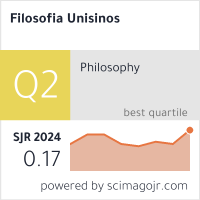Resolution of normative conflicts and paraconsistency in the William of Auxerre’s Summa aurea
DOI:
https://doi.org/10.4013/fsu.2013.142.05Abstract
William of Auxerre, in his Summa Aurea, focuses on the concept of moral perplexity (perplexitas), endeavoring to better clarify it by addressing several situations of normative conflict. In dealing with a sample of cases, he advances a resolution strategy that boils down to the adoption of the so called lesser evil principle as a criterion of choice aimed at picking out the most suitable solution among extant, conflicting alternatives. This approach is remarkable insofar as it adopts a quite adaptive standpoint on the occurrence of inconsistencies, avoids a trivialization of the underlying logic and does not completely surrender the inferential power of classical logic.
Key words: normative conflicts, paraconsistency, lesser evil principle, William of Auxerre.
Downloads
Metrics
Downloads
Published
How to Cite
Issue
Section
License
I grant the Filosofia Unisinos – Unisinos Journal of Philosophy the first publication of my article, licensed under Creative Commons Attribution license 4.0 (which allows sharing of work, recognition of authorship and initial publication in this journal).
I confirm that my article is not being submitted to another publication and has not been published in its entirely on another journal. I take full responsibility for its originality and I will also claim responsibility for charges from claims by third parties concerning the authorship of the article.










